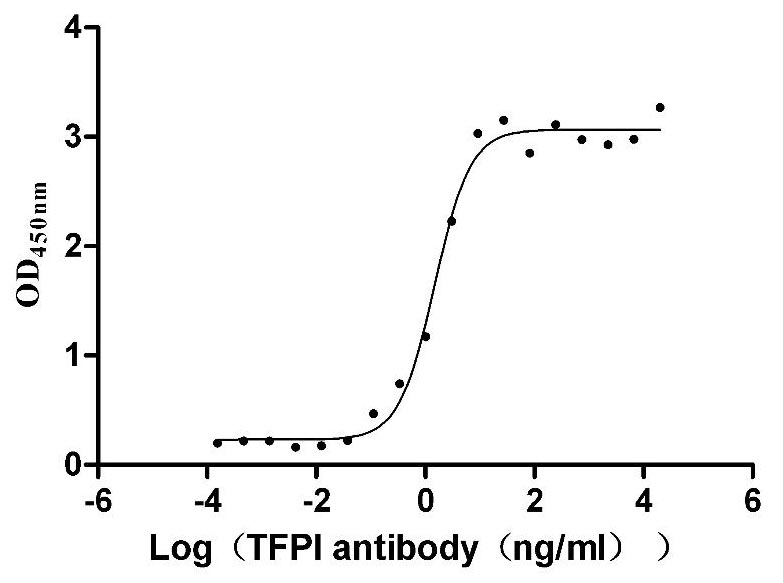Recombinant Mink cell focus-forming murine leukemia virus Gag-Pol polyprotein (gag-pol)
-
中文名稱:Recombinant Mink cell focus-forming murine leukemia virus Gag-Pol polyprotein(gag-pol),Yeast
-
貨號:CSB-YP323411MGW
-
規(guī)格:
-
來源:Yeast
-
其他:
-
中文名稱:Recombinant Mink cell focus-forming murine leukemia virus Gag-Pol polyprotein(gag-pol),Yeast
-
貨號:CSB-EP323411MGW
-
規(guī)格:
-
來源:E.coli
-
其他:
-
中文名稱:Recombinant Mink cell focus-forming murine leukemia virus Gag-Pol polyprotein(gag-pol),Yeast
-
貨號:CSB-EP323411MGW-B
-
規(guī)格:
-
來源:E.coli
-
共軛:Avi-tag Biotinylated
E. coli biotin ligase (BirA) is highly specific in covalently attaching biotin to the 15 amino acid AviTag peptide. This recombinant protein was biotinylated in vivo by AviTag-BirA technology, which method is BriA catalyzes amide linkage between the biotin and the specific lysine of the AviTag.
-
其他:
-
中文名稱:Recombinant Mink cell focus-forming murine leukemia virus Gag-Pol polyprotein(gag-pol),Yeast
-
貨號:CSB-BP323411MGW
-
規(guī)格:
-
來源:Baculovirus
-
其他:
-
中文名稱:Recombinant Mink cell focus-forming murine leukemia virus Gag-Pol polyprotein(gag-pol),Yeast
-
貨號:CSB-MP323411MGW
-
規(guī)格:
-
來源:Mammalian cell
-
其他:
產(chǎn)品詳情
-
純度:>85% (SDS-PAGE)
-
基因名:gag-pol
-
Uniprot No.:
-
別名:gag-pol; Gag-Pol polyprotein; Pr180gag-pol) [Cleaved into: Integrase p46; IN; EC 2.7.7.-; EC 3.1.-.-)]; Fragment
-
種屬:Mink cell focus-forming murine leukemia virus (isolate CI-3)
-
蛋白長度:full length protein
-
表達(dá)區(qū)域:1-156
-
氨基酸序列RNTPGPHGLT PYEILYGAPP PLVNFHDPDM SELTNSPSLQ AHLQALQTVQ REIWRPLAEA YRDRLDQPVI PHPFRTGDSV WVRRHQTKNS EPRWKGPYTV LLTTPTALKV DGIAAWIHAA HVKAATTPPA GTASGPTWKV QRSQNPLKIR LTRGAP
-
蛋白標(biāo)簽:Tag?type?will?be?determined?during?the?manufacturing?process.
The tag type will be determined during production process. If you have specified tag type, please tell us and we will develop the specified tag preferentially. -
產(chǎn)品提供形式:Lyophilized powder
Note: We will preferentially ship the format that we have in stock, however, if you have any special requirement for the format, please remark your requirement when placing the order, we will prepare according to your demand. -
復(fù)溶:We recommend that this vial be briefly centrifuged prior to opening to bring the contents to the bottom. Please reconstitute protein in deionized sterile water to a concentration of 0.1-1.0 mg/mL.We recommend to add 5-50% of glycerol (final concentration) and aliquot for long-term storage at -20℃/-80℃. Our default final concentration of glycerol is 50%. Customers could use it as reference.
-
儲存條件:Store at -20°C/-80°C upon receipt, aliquoting is necessary for mutiple use. Avoid repeated freeze-thaw cycles.
-
保質(zhì)期:The shelf life is related to many factors, storage state, buffer ingredients, storage temperature and the stability of the protein itself.
Generally, the shelf life of liquid form is 6 months at -20°C/-80°C. The shelf life of lyophilized form is 12 months at -20°C/-80°C. -
貨期:Delivery time may differ from different purchasing way or location, please kindly consult your local distributors for specific delivery time.Note: All of our proteins are default shipped with normal blue ice packs, if you request to ship with dry ice, please communicate with us in advance and extra fees will be charged.
-
注意事項(xiàng):Repeated freezing and thawing is not recommended. Store working aliquots at 4°C for up to one week.
-
Datasheet :Please contact us to get it.
靶點(diǎn)詳情
-
功能:Integrase catalyzes viral DNA integration into the host chromosome, by performing a series of DNA cutting and joining reactions. This enzyme activity takes place after virion entry into a cell and reverse transcription of the RNA genome in dsDNA. The first step in the integration process is 3' processing. This step requires a complex comprising the viral genome, matrix protein and integrase. This complex is called the pre-integration complex (PIC). The integrase protein removes 2 nucleotides from each 3' end of the viral DNA, leaving recessed CA OH's at the 3' ends. In the second step that requires cell division, the PIC enters cell nucleus. In the third step, termed strand transfer, the integrase protein joins the previously processed 3' ends to the 5' ends of strands of target cellular DNA at the site of integration. The last step is viral DNA integration into host chromosome.
Most popular with customers
-
Recombinant Human Tumor necrosis factor receptor superfamily member 14 (TNFRSF14), partial (Active)
Express system: Mammalian cell
Species: Homo sapiens (Human)
-
Recombinant Human B- and T-lymphocyte attenuator (BTLA), partial (Active)
Express system: Mammalian cell
Species: Homo sapiens (Human)
-
Recombinant Human Leukemia inhibitory factor receptor (LIFR), partial (Active)
Express system: Mammalian cell
Species: Homo sapiens (Human)
-
Recombinant Human Tissue factor pathway inhibitor (TFPI), partial (Active)
Express system: Mammalian cell
Species: Homo sapiens (Human)
-
Recombinant Human Complement component C1q receptor (CD93), partial (Active)
Express system: Mammalian cell
Species: Homo sapiens (Human)
-
Recombinant Human Claudin-6 (CLDN6)-VLPs, Fluorescent (Active)
Express system: Mammalian cell
Species: Homo sapiens (Human)
-
Recombinant Human C-C chemokine receptor type 8 (CCR8)-VLPs (Active)
Express system: Mammalian cell
Species: Homo sapiens (Human)
-
Recombinant Human Desmoglein-2 (DSG2), partial (Active)
Express system: Mammalian cell
Species: Homo sapiens (Human)







f4-AC1.jpg)










